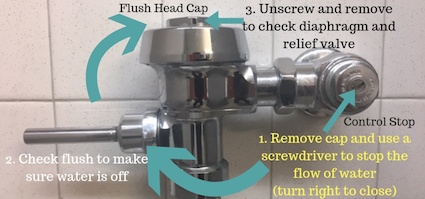If you have a business or work on commercial bathrooms, you’ll run into one problem over and over again. Eventually, the urinal keeps running and won’t stop. It happens with toilets too!
It wastes water and it’s loud. It might even cause an overflow.
The good news is that fixing a urinal that keeps running is relatively easy. I’ll guide you through the steps to revitalize your commercial urinal or toilet (they work similarly).
Commercial Urinals and Toilets
It’s important to understand that most commercial toilets are made differently than household toilets. You won’t see a tank in a commercial building and you won’t find a urinal in a home (for the most part).
Toilets that are built for commercial use are almost as easy to fix as a toilet found at home, however, there are different ways to go about fixing the toilet.
Why A Urinal Keeps Running
Why does this happen? Toilets are usually good at doing their job but every so often one will act up. In public bathrooms and commercial buildings, it’s not uncommon to see a toilet out of commission or running continuously.
In most cases, there is a problem with the diaphragm. The diaphragm moves up and down to allow water to flush the toilet. A small amount of debris can become stuck under the diaphragm, causing it to remain open after a flush, or it can wear out.
Considering how much use commercial and public toilets get, it’s understandable that the components of a toilet or urinal will need to be replaced.
Fixing A Urinal That Keeps Running

Step 1:
If possible, turn the main water line to the bathroom off and temporarily close the bathroom. This will allow you to do work without interruption and turning the main water line off will help if there’s a larger problem.
Step 2:
Locate the urinal that won’t stop running and turn the secondary water line off. The control stop turns off the water to the individual toilet (see photo).
Many urinals will have a cap over the screw that needs to be removed prior to tightening. Using a flathead screwdriver, turn right to turn off the water.
Now you’ll be able to work on the rest of the urinal without worrying about water.
Step 3:
Try flushing the toilet to make sure the water is off. After closing the secondary water line, the toilet shouldn’t be able to flush. Nothing should happen when you attempt to flush the toilet.
Step 4:
Locate the flush head cap and use a wrench to unscrew it. To protect the chrome, I use a flat wrench and a thin towel to cover the head cap while I remove it.
Use the wrench and turn to the left to loosen the cap. Some water will emerge from the cap once you’ve loosened it (this is normal).
Step 5:
Remove the cap and remove the diaphragm assembly and relief valve. Inspect these for damage or debris. Even if you can find a problem with it, it’s likely that the diaphragm assembly is the culprit. Replace and tighten the flush head cap.
Step 6:
Turn on the water by returning to the control stop and gently using a screwdriver. Turn to the left to open the water line. Once the line is open, replace the cap turn the main water line to the bathroom back on.
Once the water is back on, flush the toilet to see if the problem is solved. Prior to flushing, use a cloth to wipe down the joints and look for leaks during or after the flush. If you see a leak, try tightening the joints and flush again.
Chances are, the urinal or toilet will be back in business!
Conclusion
Does your urinal keep running? It’s annoying and it’s wasteful. I’ve walked into many commercial and public bathrooms in my day and found toilets that were running constantly.
It wasn’t until I learned about toilets did I find that it was an easy fix. The first step is using a screwdriver to turn off the water. Turn off the water and the running toilet will stop.
Next, you need to do a bit of problem-solving. Chances are, the problem is with the diaphragm. These parts wear out over time and there can be debris in the water that affects the diaphragm’s performance.
Unscrew the flush head cap and take a look inside. Do things look normal? How does the diaphragm look? How about the relief valve?
Even if these look okay, they might have a small problem you don’t see. Replace it and place the cap back on. Turn the secondary water back on and make sure the main water line to the bathroom is on, then try flushing the toilet.
I bet your urinal or toilet will be working beautifully again. This process only takes 10-15 minutes and should last years!
As usual, thanks for reading another Toilet Travels article. I do my best to provide answers to all your toilet problems. Until next time!
